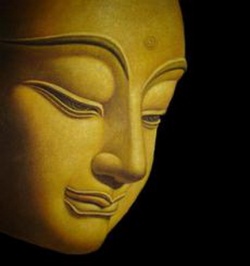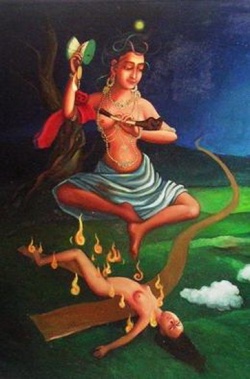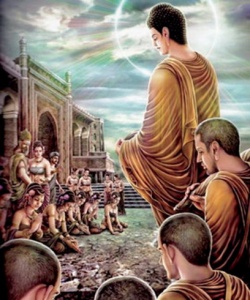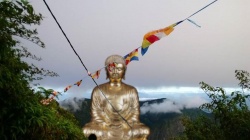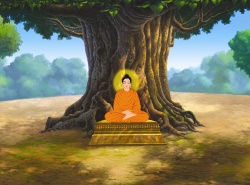Manual of Prajna Paramita - Reading Six: Who is Maitreya?
From the presentation on The Text of Maitreya found in the Overview of the Perfection of Wisdom, by Kedrup Tenpa Dargye (1493-1568):
Here is how these others make their argument. They say that “It is incorrect to relate the opening lines [of the Jewel of Realizations], the ones that are an offering of praise, to any need of the author himself. This is because Maitreya possesses no state of mind where he is aspiring to fulfill his own needs, and because the lines appear here only as a means to induce persons other than the author to follow the work.”
Here secondly is our own position. It is incorrect to make the argument that appeared earlier, for such an argument only reveals that the person making it has failed to undertake exhaustive study and contemplation of the major scriptures of the greater way. How can we say this? Let us first ask the following: do you make this argument assuming that the Holy One (Maitreya) is a Buddha, or do you make it assuming that he is a bodhisattva?
Suppose you say that you are making the former assumption. Doing so represents a failure to distinguish between speaking in the context of the way which is shared, the way of the perfections, and speaking in the context of the way which is not shared; that is, the way of the secret word.
The teaching of the secret way says that the holy Maitreya is a Buddha. This is true because—according to the secret way—Manjushri is a Buddha, and the reasons for His being so apply equally to Maitreya in every respect.
It is correct for us to say that the way of the perfections is the way which is “shared,” and that the way of the secret word is the way which is “not shared.” This is because such a description is found in a great number of authoritative works. The Steps of the Path to Buddhahood, for example, speaks about “how to train oneself in the way which is shared—the way of the perfections, and how to train oneself in the way which is not shared—the way of the secret word.” The Concise Steps as well includes the lines:
Thus is the path which is shared,
The one which is required
At both the stage of the cause
As well as the stage of result
In the higher way,
The path which is supreme.
There is another description that mentions the “way for common disciples” and the “way for unique disciples.” It is apparent that these expressions, [which use the same Tibetan term,] have the same connotation as “shared” and “not shared” above.
Someone might assert that “In the context of the way of the perfections, the way of the secret word is not accepted.” This though is incorrect, for the Brief Commentary includes a section where it states that presenting the bodies of a Buddha as being exactly four is moreover not inconsistent with the way of the secret word. This section reads: “Nor moreover is this inconsistent with the other division of the teachings.”
There are other reasons too which prove that there is a way of the secret word. It is stated with authority that the ability to fly in the sky, and other such miraculous abilities described in the Tantra of the Garuda, occur through the power of the being who has spoken the tantra. This is true because the Commentary on Valid Perception states:
There do exist the ones who know
The tantra and can in cases
Use the secret word with success;
These are the proof. It’s mainly the power
Of the one who taught it,
And following his precepts.
Beyond this type of reasoning, I personally am unable to accept all the other things that people say on this point.
Here next we will demonstrate that it is also incorrect to make the argument above under the assumption that Maitreya is a bodhisattva. We ask those who make such an argument: Are we to assume then that the definition of the wish for enlightenment presented in the Ornament is a definition which is less than comprehensive? Because isn’t it true that, according to your argument, this definition would fail to cover the wish for enlightenment at the tenth bodhisattva level?
And wouldn’t this be the case, because—according to you—wouldn’t a person at the tenth bodhisattva level have fulfilled his own needs without having to stop his feeling of being satisfied with nothing more than putting a final end to the truth of suffering and the truth of its origin?
And wouldn’t this be the case, because—according to you—doesn’t such a person aspire to fulfill his own needs completely, and yet also fail to see that attaining the Dharma Body is necessary for him to do so?
The above statements should help you grasp a number of crucial points.
Realize first of all that, if something is the greater way’s wish for enlightenment, it must be linked with an associate state of mind, an aspiration to fulfill one’s own needs, which means the Dharma Body. Realize secondly that, if something is that state of mind in which one aspires to fulfill his own needs—meaning the Dharma Body—then it is a state of mind in which one aspires to fulfill his own needs.
The above arguments demonstrate then that the Maitreya who authored the Ornament is a bodhisattva who has one life to go. This is true since the Mother includes a line which says, “Go and ask Maitreya there; he is a bodhisattva who has one life to go.” Moreover, the Higher Line states that Maitreya authored it in order to utilize the word of the Able One to purify himself of the obstacles to omniscience.
See also
- Manual of Prajna Paramita - Reading One: The Three Kinds of Refuge
- Manual of Prajna Paramita - Reading Two: The Wish for Enlightenment
- Manual of Prajna Paramita - Reading Three: What is Nirvana?
- Manual of Prajna Paramita - Reading Four: The Object We Deny
- Manual of Prajna Paramita - Reading Five: The Proofs for Emptiness
- Manual of Prajna Paramita - Reading Six: Who is Maitreya?
- Manual of Prajna Paramita - CLASS NOTES
